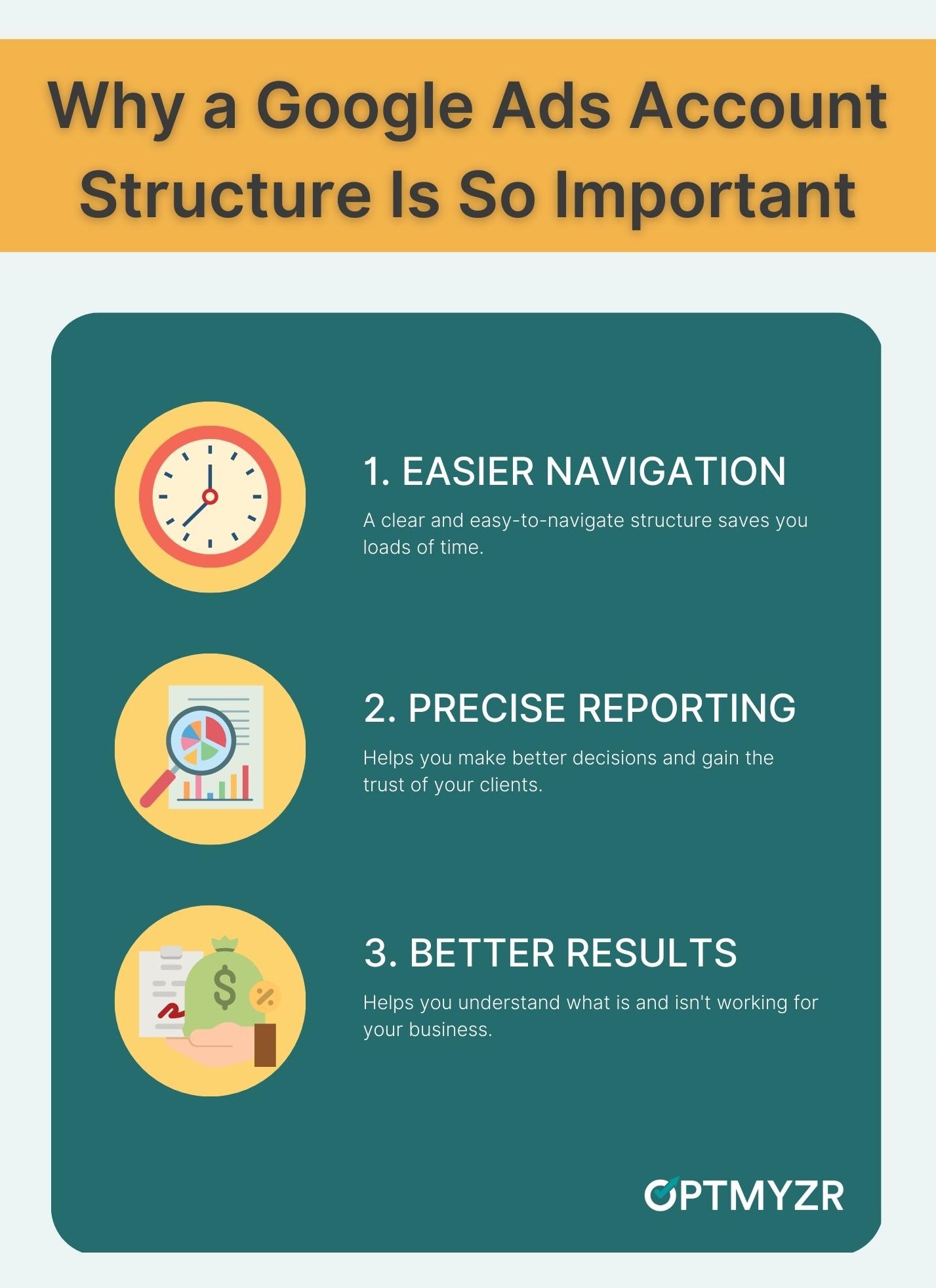There’s nothing worse than coming back to a dirty house. The washing is piled high, laundry is draped all over the furniture and there’s a ‘stench’ that fills the air.
Nobody wants to invite people into that situation and it can also be massively embarrassing. Well, no more is this metaphor true than when describing a Google Ads account structure.
As with the analogy above, a messy house can often be a sign of something else going on behind the scenes.
In a bid to help you avoid domestic chaos (from an ads perspective of course), we’ve compiled a list of reasons why having a straightforward account structure is so important and ensures you keep your house in order.
3 reasons why a Google Ads account structure is so important

1. Easier navigation
Firstly, just for your own sanity, having an easy-to-understand structure can save you LOADS of time. On an almost daily occurrence, clients, account managers, or wider members of the team may have general questions about the account and its performance.
When this is the case, there’s nothing worse for both parties than having to sit through someone muddling through a straightforward process. By having a clear and easy-to-navigate structure, you reduce the likelihood of this happening and can help to instruct those asking the question in a much more streamlined way.
2. More precise reporting
Whether working in-house, at an agency, or even for yourself, there’s nothing worse than pulling report data that’s a mess. Building on that, it can create extremely difficult situations for account managers who have to go into great detail about poorly defined accounts that contain irrelevant keywords and queries.

An enhanced structure can improve reporting and make optimization a lot smoother!
This is only going to lose the trust of the client so always ensure that the structure aligns with wider reporting goals.
3. Better results
Arguably the most important reason for a clearly defined structure is performance!
Not only does it help to clearly signpost what is and isn’t working (with poor results standing out like a sore thumb!), but a clear account structure can help improve quality scores.
Ensuring that everything from the campaign through to keyword and content matches up ensures you’re putting your best foot forward from a quality score perspective, which in turn can help to improve overall results.
Depending on how complex an account is there is also the added element of ensuring that the structure aligns with individual campaign KPIs.
For example, if you’re running campaigns that utilize different automated bid strategies (be it brand campaigns with target impression share versus product campaigns driving conversion metrics), it would be recommended to cover this element in the naming structure to help remind management teams of the campaign aims.
The flip side
There is an important element to note with structure and that is being ‘over structured’ - if you’re working across a large-scale account, where you know the inner workings like the back of your hand, just consider how an outsider may see it.
Is your detailed naming structure packed full of abbreviations really working for the client?
Do you have campaigns broken out by match type when there really isn’t enough data to warrant this approach?
While the previous hypothetical questions may work, on the one hand, it can often be beneficial to take a step back and think - ‘how can I make this easier to digest?’
The 4 important elements of a Google Ads account structure
So all of these ideas sound great, but I’m sure you’re thinking ‘but what can I do about it?’ - well fear not! Listed below are some key action points on how to set your campaign up for structure success! :
1. Clearly defined naming structures
PPC 101 here but always ensure the campaign name actually has a link to its contents! It’s such a basic thing but numerous accounts have fallen foul of ensuring keywords align with campaign names, leading to a mish-mash of everything and keyword chaos.
2. Labels
Always the lifesaver of an account. I’d always advise leaning on these when accounts scale. As mentioned though, try to ensure that these make sense, we don’t want to make more trouble for ourselves by having to spend time translating our own work!
3. Shared budgets
Shared budgets can be another great way of keeping a budget in line within a nicely ordered account. Why spend time worrying about underutilized budgets when you can automatically share this allocation with those which may be more stretched budget-wise?
Alongside our additional structure must-haves, shared budgets can be a great time saver!
4. Negative keyword lists
Please, please, please take time before launching to consider whether a campaign by campaign, account-level, or hybrid negative keyword list will be best for your account.
Nobody needs to be rueing misspent clicks when the negative keyword should have been set at the campaign level rather than the account level. Get everything tip-top by taking time to consider your approach to negatives.
Keep your house in order
So next time you’re staring into a messy account - stop for a minute, think about all the tips you’ve learned here, and ensure you’ve followed our key steps to ensure that your house is in the best shape of its life!











